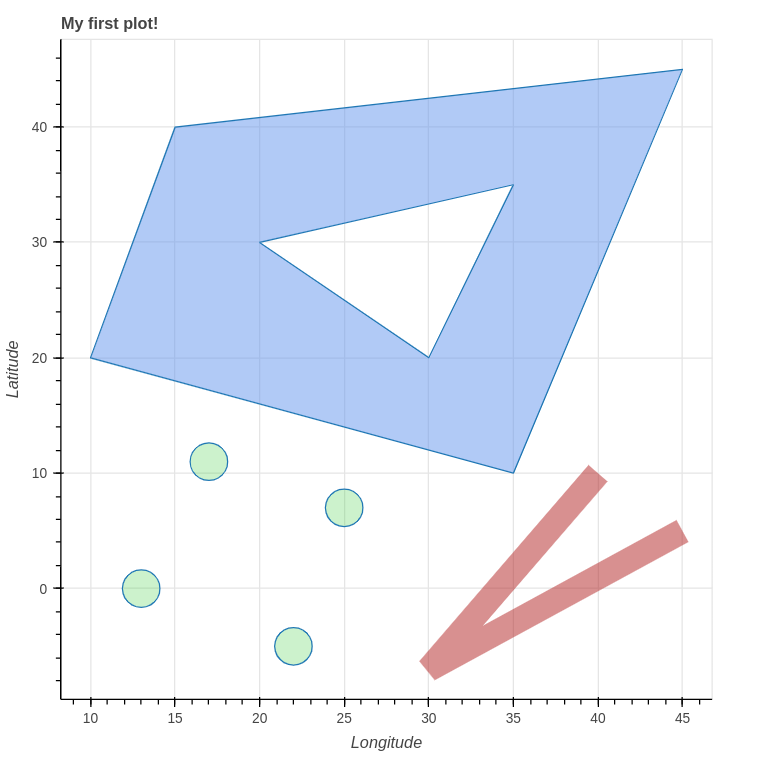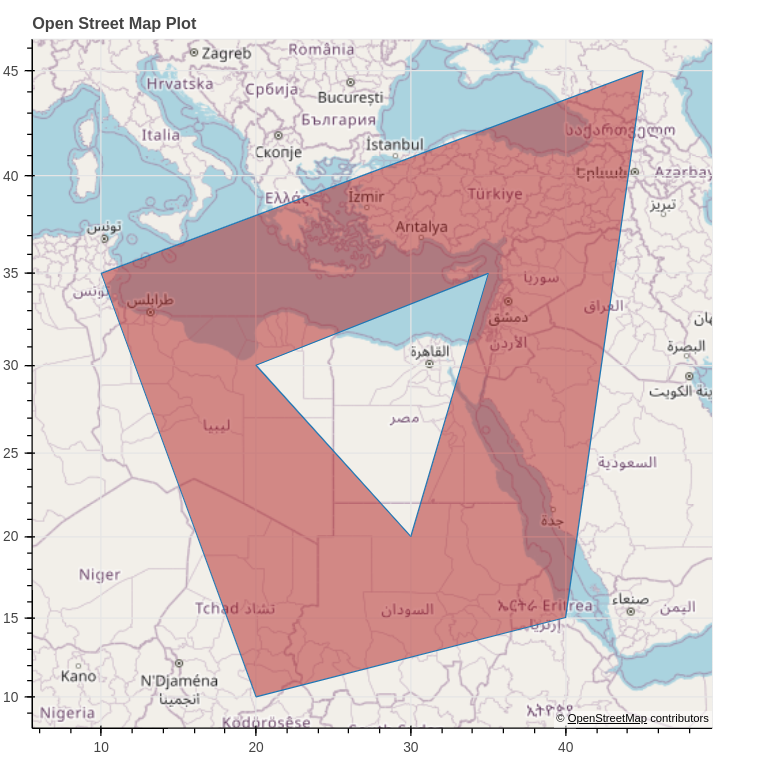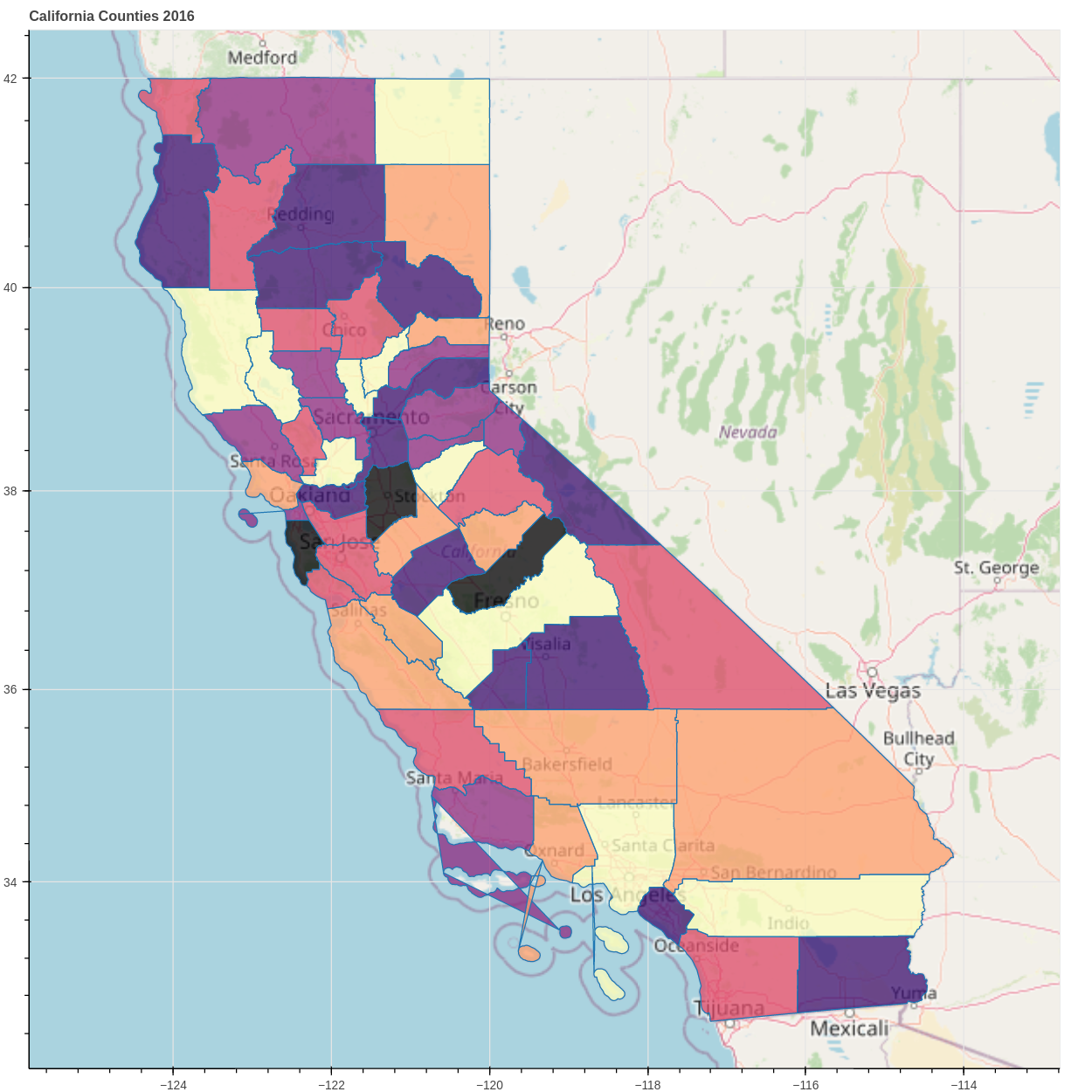Well-known-text and shapely object visualiation library
Project description
WKTPlot
Wrapper around the Bokeh library for plotting well-known-text strings and shapely geometries!
Badges
Installation
pip install wktplot
Description
The well-known-text standard is very common for working with and representing geospatial data, however it is painful to visualize them programatically. The Shapely library extends the functionality of the well-known-text standard with a rich assortment of geometry objects and operations, but it doesn't make it any easier to visualize.
WKTPlot is a library that provides an easy-to-use API for visualizing well-known-text strings and shapely objects programatically. This library wraps around the Bokeh library, which is a powerful plotting library for generating interactive visualizations. Bokeh also provides a rich assortment of stylizing options which are all usable through WKTPlot's add_shape method.
Supported datatypes
WKTPlot supports the majority of well-known-text primitives, including:
-
Point
-
MultiPoint
-
LineString
-
MultiLineString
-
LinearRing
-
Polygon
-
MultiPolygon
-
GeometryCollection
Basic Usage
from shapely.geometry import LineString
from wktplot import WKTPlot
# Create plot object
plot = WKTPlot(title="My first plot!", save_dir="/path/to/directory")
# Define shapes either through well-known-text (WKT) string, or shapely object
line_string = LineString([[45, 5], [30, -7], [40, 10]])
polygon = "POLYGON ((35 10, 45 45, 15 40, 10 20, 35 10),(20 30, 35 35, 30 20, 20 30))"
points = "MULTIPOINT (17 11, 13 0, 22 -5, 25 7)"
# Add shapes to the plot with style args
plot.add_shape(line_string, line_color="firebrick", line_alpha=0.5, line_width=20)
plot.add_shape(polygon, fill_color="#6495ED", fill_alpha=0.5)
plot.add_shape(points, fill_color=(50, 205, 50, 0.25), fill_alpha=0.7, size=30)
# Save plot to disk [/path/to/directory/my_first_plot.html]
plot.save()
OpenStreetMaps
WKTPlot now supports the ability to integrate with OpenStreetMaps. Shape coordinates will be projected to the Mercator coordinate system, which appear to distort shape proportions compared to standard geometric projection.
If your shape data has already been projected, you can disable the Mercator calculation by setting the disable_mercator parameter when creating the plot object. See Advanced Usage for an example.
# Import OpenStreetMaps plotting class
from wktplot.plots.osm import OpenStreetMapsPlot
# Create plot object just like standard WKTPlot class
plot = OpenStreetMapsPlot("Open Street Map Plot", save_dir="/path/to/directory")
shape = "POLYGON ((35 10, 45 45, 15 40, 10 20, 35 10), (20 30, 35 35, 30 20, 20 30))"
plot.add_shape(shape, fill_alpha=0.5, fill_color="firebrick")
plot.save()
Advanced Usage
Example for plotting from shapefile. Shapefile is of California's county boundaries, download from here.
import shapefile # pyshp module
from bokeh.palettes import Magma6
from pathlib import Path
from random import choice
from shapely.geometry import Polygon
from wktplot.plots.osm import OpenStreetMapsPlot
COUNTIES_PATH = Path("/path/to/CA_Counties_TIGER2016.shp")
# Create plot and disable mercator calculation
# because data has already been projected
plot = OpenStreetMapsPlot(
title="California Counties 2016",
height=1000,
width=1000,
disable_mercator=True,
)
# Read shapefile data points from file
with shapefile.Reader(COUNTIES_PATH) as shp:
for shape in shp.shapes():
plot.add_shape(
shape=Polygon(shape.points),
fill_color=choice(Magma6),
fill_alpha=0.75,
)
# Save plot to disk [./california_counties_2016.html]
plot.save()
Which will result in this output:
Development
Bugs / Feature Requests
Please open an Issue in Github with any bugs found or feature requests, and follow the prompts so that developers can reproduce or implement the necessary changes.
Local development
Development of this model is centered around the Makefile. All you need to spin up a working environment to build and test this module can be done with the Makefile.
-
Clone the repository onto your machine.
git clone https://github.com/FuzzFoundation/WKTPlot.git
-
Create the Python virtual environment and install module's development / testing dependencies. This will also install WKTPlot in develop mode.
make develop -
Activate virtual environment
source venv/bin/activate
-
Run linting and unittests.
make test
-
When you want to remove the virtual environment and clean up after development.
deactivate make clean # This will remove all generated files, like .coverage and build/ make sparkling # This will remove all generate files and the virtual env.
Project details
Release history Release notifications | RSS feed
Download files
Download the file for your platform. If you're not sure which to choose, learn more about installing packages.
Source Distributions
Built Distribution
Hashes for wktplot-2.3.2-py2.py3-none-any.whl
| Algorithm | Hash digest | |
|---|---|---|
| SHA256 | 08040287cbdc9c0355a3e8ce3e47d70561a2f0bbcc2614f7a2a133a097f35656 |
|
| MD5 | c3a5ac5947c173b12f30e07a290c2e7e |
|
| BLAKE2b-256 | f51ef6df6002b31c95b27a770aa771d3148f536d313f897f06e1ac7aa8d8370d |


















